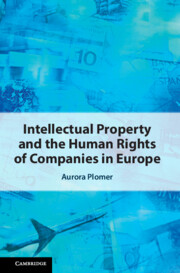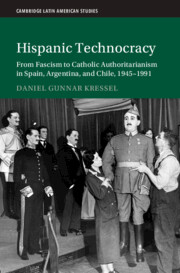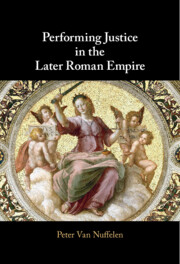Refine search
Actions for selected content:
3372210 results

The Cambridge Companion to British Postmodern Fiction
-
- Published online:
- 07 August 2025
- Print publication:
- 21 August 2025

Intellectual Property and the Human Rights of Companies in Europe
-
- Published online:
- 07 August 2025
- Print publication:
- 21 August 2025

Hispanic Technocracy
- From Fascism to Catholic Authoritarianism in Spain, Argentina, and Chile, 1945–1991
-
- Published online:
- 07 August 2025
- Print publication:
- 14 August 2025

Performing Justice in the Later Roman Empire
-
- Published online:
- 07 August 2025
- Print publication:
- 21 August 2025
ASR volume 4 issue 4 Cover and Front matter
-
- Journal:
- African Studies Review / Volume 4 / Issue 4 / December 1961
- Published online by Cambridge University Press:
- 07 August 2025, p. f1
-
- Article
-
- You have access
- Export citation
4 - Why Generative AI Is Not Cyrano de Bergerac
- from Part I - Understanding Generative AI from Multidisciplinary Perspectives
-
-
- Book:
- The Cambridge Handbook of Generative AI and the Law
- Published online:
- 08 August 2025
- Print publication:
- 07 August 2025, pp 43-64
-
- Chapter
- Export citation
1 - An Invitation
-
- Book:
- ADE
- Published online:
- 01 August 2025
- Print publication:
- 07 August 2025, pp 1-6
-
- Chapter
- Export citation
Chapter 5 - Love Your Neighbor (Leviticus 17–22)
-
- Book:
- The Theology of the Book of Leviticus
- Published online:
- 18 July 2025
- Print publication:
- 07 August 2025, pp 157-202
-
- Chapter
- Export citation
Turning points and transformations in contemporary Italy: a century of big changes through ‘small histories’
-
- Journal:
- Modern Italy , First View
- Published online by Cambridge University Press:
- 07 August 2025, pp. 1-9
-
- Article
-
- You have access
- HTML
- Export citation
Shade tree pruning effects on flowering and cacao yields in different cropping systems in a long-term trial in Bolivia
-
- Journal:
- Experimental Agriculture / Volume 61 / 2025
- Published online by Cambridge University Press:
- 07 August 2025, e22
-
- Article
-
- You have access
- Open access
- HTML
- Export citation
Tables
-
- Book:
- The Cambridge Handbook of Generative AI and the Law
- Published online:
- 08 August 2025
- Print publication:
- 07 August 2025, pp xi-xii
-
- Chapter
- Export citation
Third Conference on African History and Archaeology
-
- Journal:
- African Studies Review / Volume 4 / Issue 3 / October 1961
- Published online by Cambridge University Press:
- 07 August 2025, pp. 10-11
-
- Article
- Export citation
Chapter 2 - Public Dissension
-
- Book:
- The Power of Dissent
- Published online:
- 07 August 2025
- Print publication:
- 07 August 2025, pp 53-93
-
- Chapter
- Export citation
Year 2000
-
- Book:
- The Hans Blix Iraq War Diaries
- Published online:
- 26 July 2025
- Print publication:
- 07 August 2025, pp 1-54
-
- Chapter
-
- You have access
- HTML
- Export citation
Dedication
-
- Book:
- Operation Wrath of God
- Published online:
- 12 August 2025
- Print publication:
- 07 August 2025, pp v-vi
-
- Chapter
- Export citation
2 - The Concept of Paradata
-
-
- Book:
- Paradata
- Published online:
- 05 August 2025
- Print publication:
- 07 August 2025, pp 11-39
-
- Chapter
-
- You have access
- Open access
- HTML
- Export citation
Bianchi Modular Forms and the Rationality of Periods
-
- Journal:
- Canadian Mathematical Bulletin / Accepted manuscript
- Published online by Cambridge University Press:
- 07 August 2025, pp. 1-20
-
- Article
-
- You have access
- Export citation
Figures
-
- Book:
- The Cultural Politics of Digital User Experience Writing
- Published online:
- 24 July 2025
- Print publication:
- 07 August 2025, pp viii-viii
-
- Chapter
- Export citation
Chapter 2 - Sin, Sacrifice, and Atonement (Leviticus 1–7, 16)
-
- Book:
- The Theology of the Book of Leviticus
- Published online:
- 18 July 2025
- Print publication:
- 07 August 2025, pp 32-82
-
- Chapter
- Export citation
Annual Meeting of the Association
-
- Journal:
- African Studies Review / Volume 4 / Issue 2 / May 1961
- Published online by Cambridge University Press:
- 07 August 2025, pp. 30-31
-
- Article
- Export citation
